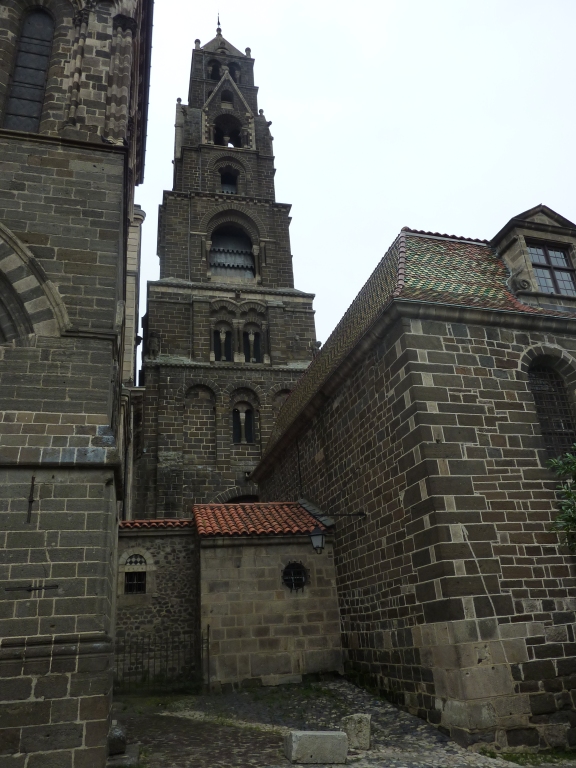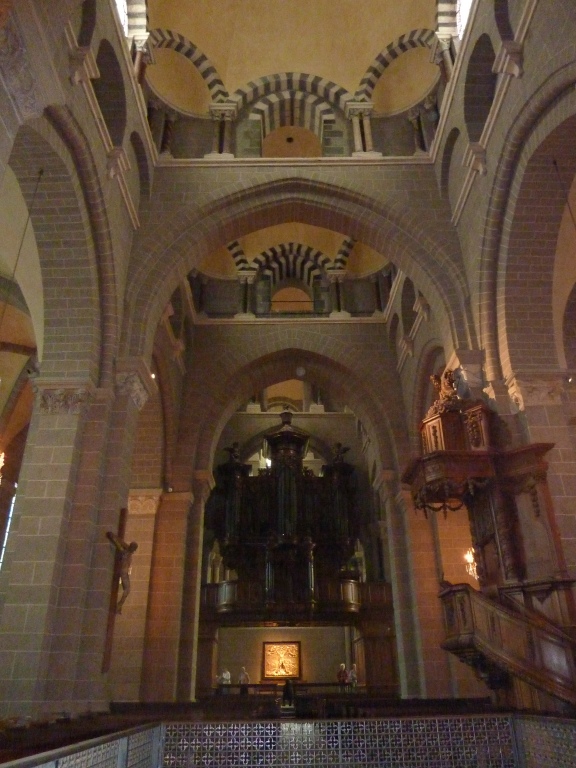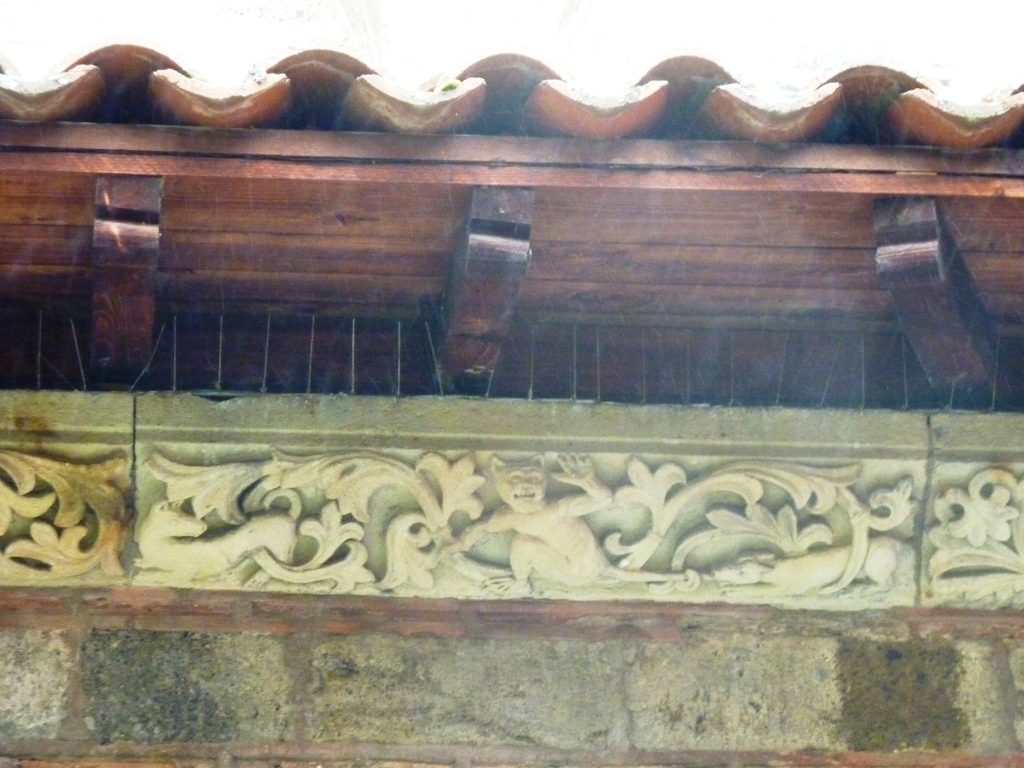Day 13 doesn't figure in this blog because it was a long, slow and tedious train-journey with five changes lasting the whole day. This journey was inevitable since I had to get back to my car in the Auvergne and there was no quicker way to do it since the TGV that could have shortened the day by half didn't take bikes.
Day 14 was a day spent visiting the town of Le Puy-en-Velay after a second night spent in Madame Caro's B&B. The poor lady had to wait up for me since my train arrived at 11.30 in the evening. She opened the door to me looking bleary-eyed and snapped, "where are you coming from at this hour?" She seemed to have forgotten both that we had agreed on my late arrival and that I had had to get the train back from my final destination at Saumur. The following morning, after breakfast, I think she was heartily glad to see the back of me, since we repeated the comedy of lugging the bike up from her cellar and since she was still fussing about my back, she felt obliged to help.
Le Puy-en-Velay is well worth a visit.
The old town has a peculiar quality for anyone nor accustomed to seeing buildings constructed from black basalt. Even the streets are cobbled with the stuff.
The arches are built out of it.
And so is everything else.
I took a look at the cathedral, which is notable as one of the most significant works of Romanesque art in Europe.
It's approached by a grand staircase that emerges in the middle of the nave.
It's entirely built of volcanic stone of various colours and shows a wide variety of influences including Byzantine and Islamic. The cathedral dates from the eleventh century, but was so delapidated in the nineteenth century that Viollet-le-Duc virtually demolished and rebuilt it, so extensive was his restoration. But then he had very definite ideas as to what constitutes restoration and boundless confidence concerning his own judgement.
The church has a number of so-called 'black Madonnas', one behind the main altar
and another in a side chapel.
Theories about the origin of black Madonnas abound and range from speculations about a christianization of the Egyptian goddess Isis, holding the baby Horus (a common image in ancient Egypt) to flat-headed rationalistic explanations involving the effects of wax- and incense smoke on the colour of wood.
The cloister is more or less intact, though many of the Romanesque capitals on the columns are faithful
reproductions of the originals. It resembles in many respects the architecture of the cathedral (once grand mosque) of Cordoba.
Thanks to the efforts of Prosper Mérimé a number of works of art were discovered and saved from destruction, including the almost Byzantine painting of the fresco in the salle capitulaire below.
The east and west sides of the cloister are quite distinct.
At the end of the western side of the cloister is a magnificent medieval wrought-iron gate.
The frieze running around the roof of the cloister has a wealth of carving, some humorous, some scurrilous.
The one above, for example, shows the Devil having his tail yanked by a mischievous dog.
The most intriguing site in Le Puy-en-Velay for me, however, was the church of Saint Michel in the suburb of Aiguilhe.
Built on top of a volcanic plug, from the distance it appears to be no more than an excrescence from this rocky outcrop.
But closer up, its architectural features become apparent.
And closer still, even more so.
I walked to Aiguilhe while waiting for the cloister to open at the cathedral, but in the end I found this little chapel on top of its pinnacle more interesting than the cloister.
I paid my 2€ 50 and climbed the 268 steps to the chapel. The volcanic plug upon which it stands once held a prehistoric dolmen which is now incorporated into the church, as are the remains of a Roman temple dedicated to Mercury. Apart from the increasingly dramatic view of the town, the first thing that strikes you on reaching the summit is the doorway.
The multifoil arches and the vegetal tracery within them recall the Islamic architecture of Omayyad Cordova, influence from which spread along the pilgrim routes of Saint-Jacques de Compostelle, particularly along the Via Podiensis that begins in Le Puy-en-Velay and still attracts thousands of pilgrims every year to this day. Above the arch are representations of Saint John, the Virgin Mary, Christ, the archangel Saint Michael and Saint Peter.
The interior is no less striking. Cut out of the rock,
it resembles a cavern with stalactites meeting stalagmites more than a church.
Medieval paintwork from the tenth century still survives around the altar.
And the ceiling has a striking design from the same period featuring the four evangelists surrounding the very eastern motif of Christ in glory.
The whole site is surrounded by reminders of the medieval piety in which this town is soaked.
At the foot of the pinnacle is the Chapelle Saint-Clair a little octagonal building dating from the seventeenth century.
The information plaques one comes across everywhere stress the volcanic nature of the landscape and there is as much detail on the geology of the area as there is on the religious history.
The Chapelle Saint-Michel appears to be a continuation of the volcanic ejection and the only difference between the stone of the pinnacle and that of the church is that the latter was put there by human hands rather than by the so-called 'blind' forces of nature. Whether such a distinction is in any way valid is a matter for debate. For me, the little chapel of volcanic rock on top of its volcanic spike stressed the complete continuity between the forces that have shaped the planet and those that have shaped human culture. I am unable to identify any hiatus between the two material processes.
I bought a few souvenirs of Le Puy including a bag of the local lentils, a bag of verveine and a piece of nineteenth century lace form the lady below, the last real producer of the genuine article in a town where lace production was once a major industry.
After this bit of shopping, I collected my bike and set off for the Place Michelet. I had arranged to meet a certain Monsieur Gardès here who, Madame Rippert from La Bigue had assured me, would transport me and my bike most of the way back to her B&B. My telephone conversation with him hadn't inspired me with confidence, since he had grumbled about the strangeness of my request and seemed to doubt whether the bike would fit into his vehicle. It turned out, however, that he was a charming chap who ran a minibus service between Le Puy and Le Béage twice a week. (Tel: 04 75 38 83 67)
He had thoughtfully removed two seats from his minibus specially to cater for my needs and the bike went in with ease, so that was that. We waited a little while for his passengers to arrive - all from the country and in the town for shopping - and then we left. He entertained me and the old ladies travelling with us during the hour-long journey to La Bigue with tales of his ancestors, all of whom had run a transport service from Le Béage to Le Puy in previous centuries, a journey that, before the internal combustion engine had taken three complete days and sometimes more in winter.
We arrived in Le Béage in a thick mist and a horizontal drizzle. Monsieur Gardès went out of his way to take me as close to my destination as possible without driving me the whole way there.
I rode the last few (downhill) kilometres and arrived back at La Bigue a little damp, but relieved that I hadn't had to do the first day's ride in reverse. The large, over-friendly dog was there to greet me but got rather short shrift. I somehow think I wouldn't have survived the climbs, the wind and the driving rain, since the fatigue that had built up over two weeks and that had been kept at bay by the determination to finish the trip, was beginning to make itself felt.




























No comments:
Post a Comment